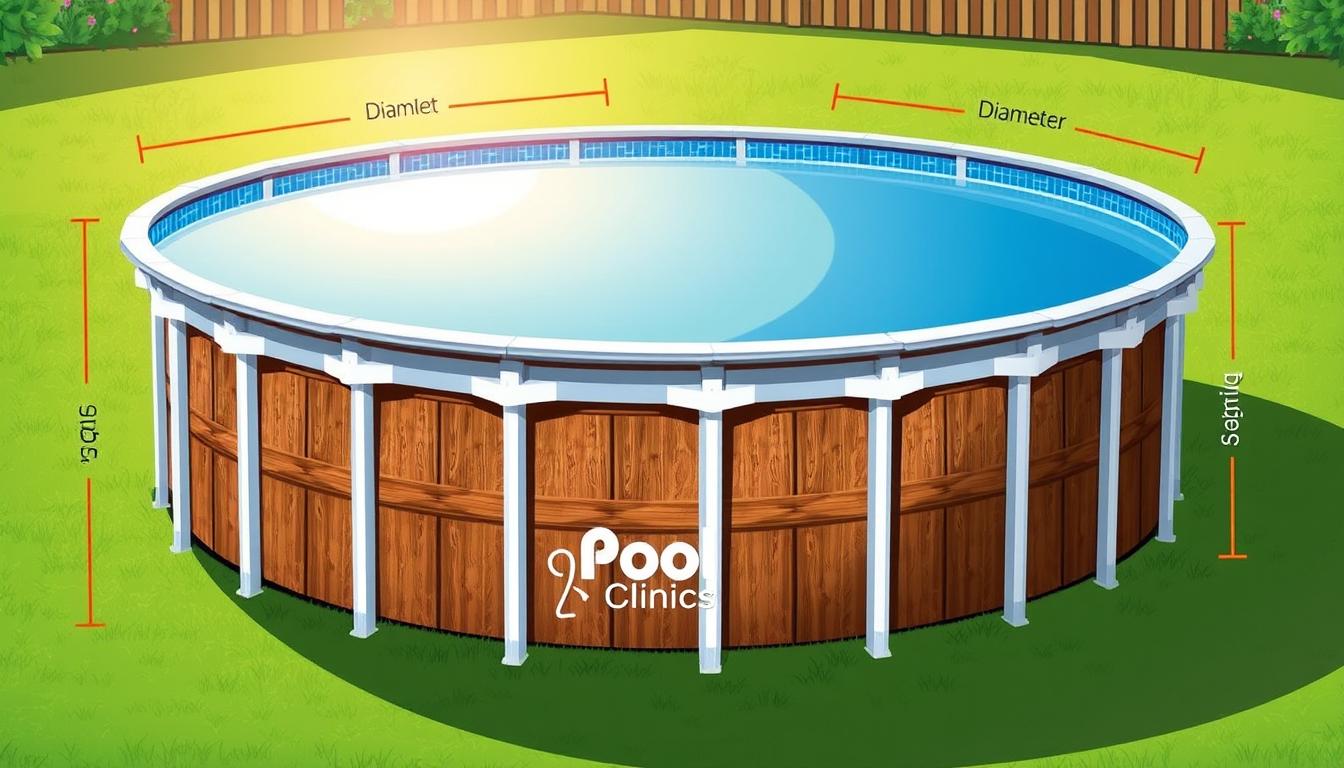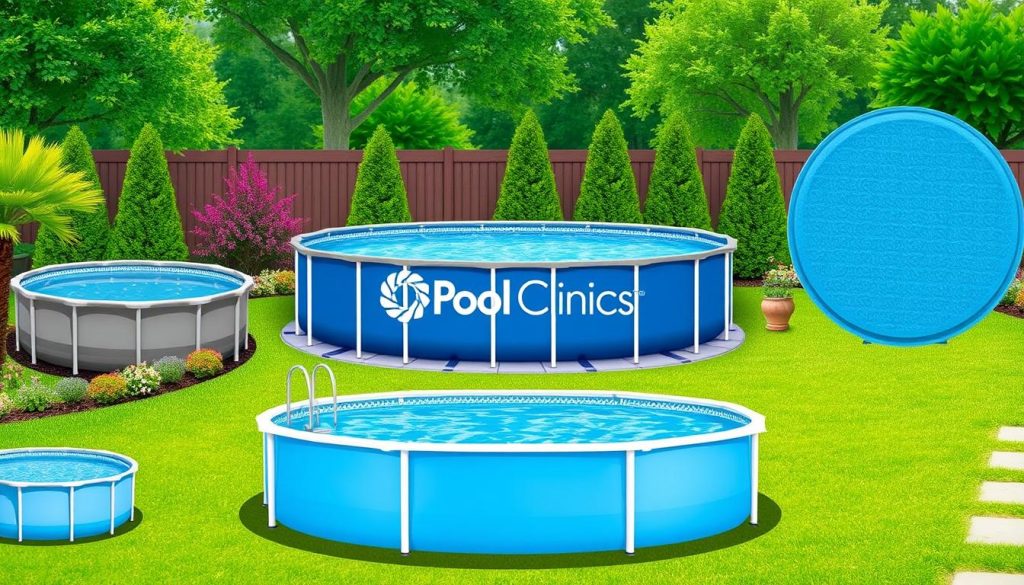
Installing a new above ground pool brings excitement. But before you dive in, it’s crucial to set it up correctly. Accurate pool measurements are key for proper installation and enjoyment.
Measuring your above ground pool is vital for both new and experienced owners. It ensures optimal water chemistry and a perfect fit for your pool liner. Some manufacturers may provide inaccurate sizes, so taking your own measurements is important.
Ready to measure? Grab a tape measure and follow our simple steps. We’ll guide you through measuring round, oval, or rectangular pools.
Knowing your pool’s exact size helps with initial setup and future maintenance. It’s crucial for filling, replacing the liner, and keeping your pool in top shape.
Key Takeaways
- Accurate pool measurements are crucial for proper setup and maintenance
- Pool manufacturers may undersize or oversize pools, so it’s important to take your own measurements
- Measuring your pool is essential for ensuring a perfect fit for your pool liner
- Knowing your pool’s exact size is necessary for filling, replacing the liner, and maintaining optimal water chemistry
- Follow easy steps to measure round, oval, or rectangular above ground pools
Understanding Pool Sizes and Shapes
Above ground pools come in various sizes and shapes. Round, oval, and rectangular are the most common. Each shape has its own benefits and drawbacks.
Finding the right pool depends on your yard and family needs. Consider these factors when choosing your pool shape and size.

Round Pools
Round pools are popular for their classic look. They fit well in smaller yards. Common sizes range from 18 to 33 feet in diameter.
Depending on size, round pools can fit 3 to 10 swimmers. The 24-foot diameter is often the most popular choice.
- 18 feet diameter
- 24 feet diameter
- 27 feet diameter
- 30 feet diameter
- 33 feet diameter
Oval Pools
Oval pools work well in narrow or rectangular yards. They offer more length for lap swimming and activities. Popular sizes include 12’x24′, 15’x30′, and 18’x33′.
Oval pools cost more than round ones. They need extra support on the sides and longer installation time. Plan for three extra feet on each side for over-dig.
- 12’x24′
- 15’x30′
- 18’x33′
Rectangular Pools
Rectangular pools are compact and elegant. They’re perfect for smaller yards or modern looks. Common sizes are 12’x20′, 12’x24′, and 16’x32′.
These pools offer space for laps and fun activities. They’re also great for custom designs.
- 12’x20′
- 12’x24′
- 16’x32′
| Pool Shape | Common Sizes | Considerations |
|---|---|---|
| Round | 18′, 24′, 27′, 30′, 33′ diameter | Classic look, fits well in smaller yards |
| Oval | 12’x24′, 15’x30′, 18’x33′ | Great for narrow yards, offers more length for swimming laps |
| Rectangular | 12’x20′, 12’x24′, 16’x32′ | Compact and elegant, suitable for smaller yards or custom designs |
The right pool depends on your yard size, budget, and intended use. Consider these factors when making your choice. With the right pool, you’ll enjoy years of fun and relaxation.
How to Measure Above Ground Pool
Measuring your above ground pool correctly is vital for getting the right pool liner size. We’ll show you how to measure round, oval, and rectangular pools, plus determine wall height.
Measuring Round Pools
Start by standing in the pool’s center. Measure from one inside wall to the other in a straight line. Take measurements from different angles to check for a perfect circle.
Most round above ground pools come in whole feet sizes like 21′, 24′, 27′, and 30′.
Measuring Oval Pools
Oval pools have standard sizes but can vary. Measure the length inside the walls from end to end. Find the pool’s middle and measure the width between inside walls.
Measuring Rectangular Pools
For rectangular pools, measure the length inside the walls from side to side. Then, find the center of a long wall and measure the width between inside walls.
Measuring Pool Wall Height
Find a spot where you can see the entire wall. Measure from the ground to the wall’s top. Most pool walls are 48″, 52″, or 54″ high.
This measurement helps determine the right pool liner dimensions.
| Pool Type | Measuring Instructions |
|---|---|
| Round | Measure diameter from inside wall to inside wall |
| Oval | Measure length and width from inside walls |
| Rectangular | Measure length and width from inside walls |
| Wall Height | Measure from ground to top of wall |
Precise pool measurements help calculate pool volume for proper water treatment. Following these steps ensures you order the right pool liner size for a perfect fit.
Conclusion
Measuring your above ground pool is vital for a perfect liner fit. It ensures a safe, clean swimming environment. These pool measurement tips help you determine dimensions for round, oval, or rectangular pools.
Accurate measurements are crucial for selecting the right pool liner replacement. They also help calculate water volume for chemical treatments. This information optimizes filtration cycles for regular pool maintenance.
Quality above ground pool accessories can improve your swimming experience. They also extend your pool’s lifespan. Covers, blankets, skimmers, and vacuums keep your pool clean and inviting.
Understanding your pool’s water capacity is essential for proper chemical balance. It also ensures your filtration system works effectively. Accurate measurements help maintain a balanced and healthy pool.
Precise pool measurements and regular maintenance create a fantastic backyard oasis. With the right knowledge and tools, you’ll enjoy your above ground pool for years. Your private paradise will be the perfect spot for making lasting memories.







